 Research Article
Research Article
Recycled Rebonded Polyurethane Foam as Sustainable Thermal Insulation
Todorka Samardzioska* and Milica Jovanoska-Mitrevska
Faculty of Civil Engineering, Ss. Cyril and Methodius University in Skopje, Macedonia
Todorka Samardzioska, Full Professor, Faculty of Civil Engineering, Ss. Cyril and Methodius University in Skopje, Macedonia.
Received Date:February 07, 2023; Published Date:February 20, 2023
Abstract
The use of polyurethane foam materials is extensive, leading to a great production of polyurethane foam waste. Due to the difficult degradation, it has a negative effect on the environment. Since polyurethanes are petrochemical-based polymers, it is important to recycle them whenever possible. Depending on the type of polyurethane, different recycling methods can be applied, such as grinding and rebounding. Therefore, this paper focuses on investigating the possibility of using recycled polyurethane foam as a thermal insulation material. Laboratory tests were carried out on a large number of samples of the material, in order to determine the size of the thermal conductivity, depending on the variation of certain parameters, such as: density, humidity of the material, etc. The thermal conductivity of the recycled rebonded polyurethane was obtained with an average value of 0.039 W/m·K. Tests showed that varying the density from 60 to 100 kg/m3 has no noticeable effect on thermal conductivity. According to the conducted research, the recycled rebonded foam showed pronounced water absorption in all tested saturated samples. The mass and density of the wet samples are almost three times that of the dry samples. The difference between the highest and the lowest value of the obtained thermal conductivities is 3.4%, which shows that the density variation has no effect on the thermal conductivity of the wet recycled rebonded polyurethane foam. The average value of the thermal conductivity of wet samples is 0.115 W/m·K, which is 2.95 times that of the dry samples. The obtained results testify that recycled rebonded polyurethane can find use as thermal insulation, for reduction of energy consumption in buildings and greenhouse gas emissions. Built-in thermal insulation of this type is competitive with traditionally used insulation materials, offers greater thermal comfort, increases quality of life, while having economic and ecological dimension.
Keywords:Recycled rebounded polyurethane; Thermal conductivity; Energy; Buildings; Thermal insulation
Introduction
Problems related to the disposal of waste from insulation materials in landfills and environmental problems related to crude oil are the key ones facing modern society. Using natural, organic and/ or biodegradable, as well as recycled insulation materials, will contribute to limiting the consumption of natural resources. Through careful waste management, using recycling and reuse procedures, ecosystems and natural environments can be preserved. According to the basic principles of sustainable development, the needs of current generations will be met, without jeopardizing the abili ty of future generations to meet their own needs. Energy costs for heating, cooling and air conditioning are the highest items in home maintenance. Therefore, during the construction of new and reconstruction of existing houses and residential buildings, special attention should be paid to the choice of building materials for thermal insulation. Polyurethane foam is just one of the insulating materials that has been proven to reduce heat loss, and thus the total energy consumption. Depending on the formulation and the basic chemical mixture, the spectrum of properties of polyurethanes can be precisely determined by the type of production – hard or soft, integral or compact. The result is dedicated and economical solutions for almost every field of application. According to a Report published by Plastic Europe-the Facts in 2017 [1], the demand for plastics in Europe in 2016 was 49.9 MTn, 3.1% more than in 2014. Of this demand, 7.5% is polyurethane, implying an annual demand of 3.78 MTn in 2017. Of the 3.78 MTn, approximately 70% is in the form of foam (1.40 MTn flexible foam and 1.22 MTn rigid foam), 30% is that of polyurethane elastomers and other products. Of the 2.62 MTn of polyurethane foam, approximately 27% (700,400 Tn) of waste is generated, 31.1% of which is recycled (220,000 Tn), 41.3% is incinerated (294,278 Tn), and the remaining 27.3% are taken to landfill (193,120 Tn). The sectors according to demand are: construction and facilities (24.5%); automotive industry (19.5%), refrigeration (21.3%) and other sectors in the textile industry, use in technology, etc. (34.7%), according to Gomez-Rojo et al. [2].
Polyurethane is one of the most used three-dimensional polymers, as it can exist in a variety of panel forms, adhesives and paints. Therefore, its production is continuously increasing. According to He et al. [3], the current annual production of polyurethane is close to 30 million tons, which represents 7.9% of the total production of plastics. It is the fifth most used polymer in the world. Polyurethanes are usually produced with polymerization through the interaction between polyols and Poly isocyanate, as described by Simón [4]. Polyols (polyether and polyester) and isocyanate are the two main raw materials for the production of polyurethane foam, and they are currently obtained from fossil non-renewable resources. The main disadvantage of petroleum-based products is that they are non- renewable and non-biodegradable, Kiss et. al [5]. Therefore, polyols should be replaced with more diverse, cheaper, renewable and ecological components, as the world becomes aware of the environmental problem as well as of the scarcity of non-renewables. Large scale commercial use leads to the generation of waste, which causes environmental impacts if not reused or properly disposed of. Since polyurethane is one of the most versatile and adaptable polymeric materials widely used in various applications of daily life, large amounts of waste appear, therefore its recycling is a priority task. The natural slow decomposition of polyurethane materials and the careless management of its disposal impose a serious threat to environmental pollution when these materials are disposed of. Also, the amount of polyurethane foam debris from demolition or reconstruction of buildings is increasing and the question of its recycling is being raised. Recycling polyurethanes is the most effective and economical alternative approach, rather than leaving them in landfills exposed to the decomposition process. In this way, in addition to saving energy for their re-production, the natural environment is also preserved. There are three ways to recycle polyurethanes: mechanical recycling, chemical recycling and reprocessing. Mechanical recycling consists of crushing or grinding polyurethane waste and then reprocessing it. Mechanical recycling is by far the most effective and economical way to recycle, Guo et al. [6].
A new biodegradable polyurethane foam is being researched in many countries, but traditional polyurethane foams cannot be replaced in a short time because of their high cost. For these reasons, the aim of this research is to investigate and study the proper handling of polyurethane foam waste, and to create a new product applicable in construction, competitive with other thermal insulation materials. The aim of this paper is to assess the sustainability in terms of use of recycled polyurethane foam products and to enable the reuse of waste polyurethane foam. Recycled polyurethane used in this research is obtained by mechanical recycling, produced from ground polyurethane foam, pressed and bonded with a binder. The paper discusses the influence of different densities and porosities of the recycled rebonded polyurethane foam on the thermal properties, i.e. thermal conductivity. The water absorption of the material is also analyzed, as well as the influence of humidity on the thermal characteristics. There is numerous research on the thermal characteristics of polyurethane foam in the world. However, the properties and behavior of recycled rebonded polyurethane foam are rare. Although recycled polyurethane foam has been used for a long time, the potential for its use in construction has not yet been sufficiently explored. The different ways of recycling define different properties of the newly obtained polyurethane foams, both physical and mechanical, as well as thermal. Many researchers who point out the use of natural or biomaterials as thermal insulations, show that the thermal properties of natural and reused materials are comparable to those of classic insulating materials, such as mineral wool, polystyrene, etc. Several world authors, such as Randall & Lee [7], Yang et al. [8], Edurne et al. [9], Wang et al. [10], Sonnenschein [11] and others, investigated the possibilities of recycling polyurethane foams, materials and methods, physical-mechanical properties of the newly obtained recycled products etc. Tantisattayakul et al. [12] researched options for managing rigid polyurethane waste (RPUW) remaining from refrigerator/freezer dismantling in Thailand. The assessment was made conducted from environmental, energy, and economic perspectives.
The authors Gomez - Rojo et al. [2], analyzing five different forms of recycled polyurethane, concluded that the water absorption of each waste varies according to the structure and morphology of the foam. Namely, the flexible foam showed the highest absorption capacity, up to 660% at full saturation, due to the pronounced high porosity of the cells. Actually, the water penetrates inside the foam much more easily due to the pores between the cell walls. Accordingly, foams with semi-closed and closed cell structures exhibited lower water absorption. He et al. [3] used waste polyurethane foam in the form of rigid board, the most commonly used type of building insulation material in China. Higher crushing speed and longer time improved the crushing effect, but the mechanical energy consumption was greatly increased and the efficiency was lower. At 1500 r/min and 40 min, polyurethane foams can be effectively degraded and have the highest cost performance. The obtained thermal conductivity of the recycled material ranged from 0.0370 to 0.1236 W/m·K for a series of performed tests. The larger the recycled polyurethane particles are, the more they can preserve the thermal insulation properties of the polyurethane foam itself, but too large particles will reduce the bond between the polyurethane foam particles and polypropylene, and the mechanical properties of the recycled board will be poor. Jovanoska-Mitrevska et al. [13] measured the sound absorption coefficients at normal incidence and air resistivity of the same material, proving the possibility of its use as a protection against noise and vibration.
Materials and Methods
Testing thermal conductivity
Rebonded recycled polyurethane foam is produced by mechanical reprocessing of shredded polyurethane foam waste pieces, mixed with binder. The mixture was compressed in a mould, obtaining different densities and then cured with steam at 200 - 250 °C. The production of the material is described in more detail in [13]. The thermal conductivity of polyurethane foams is due to three forms of heat transfer: convection in the mixture of gases in the cells, conduction in the solid polymer and radiation between the cell walls. However, with the mechanical recycling of polyurethane foams, a product is obtained with an inhomogeneous distribution of the volume mass, and therefore different density and hardness in the different parts of the produced material appear. The thermal conductivity was determined in laboratory conditions at the Faculty of Civil Engineering in Skopje, using the instrument for measuring thermal conductivity Heat Flow Meter (HFM) 436/3, presented in Figure 1a and Q-LAB software for data reading, analysis and control [14]. Testing is based on the measurement of the heat flow through the samples with special heat flux sensors, according to MKS ISO 8301:2016, [15]. The sample is placed between two heating plates, hot and cold plate, set at different temperatures, as shown in Fig. 1b. The lower plate is fixed, while the upper one can be adjusted to the sample’s thickness. The test ends when equilibrium is established in the tested sample, i.e. when the heat transfer is completed as a result of the two heating plates being set at different temperatures.

Heat flow through the sample is measured. It depends on several
factors:
• thermal conductivity of the sample (𝜆)
• sample thickness (Δx)
• temperature gradient (ΔT)
• surface area of the heat flow (A)
The heat flux is calculated according to Fourier’s law:

On the other hand, the heat flux can be presented with the following equation:

where N is a calibration factor relating the voltage signal of the heat flow sensor to the heat flow through the sample. The heat flow sensor signal (in volts, V) is proportional to the heat flow through the sensor. In the measuring instrument, the surface of the heat flow sensor represents the surface through which the heat flows, and it is the same for all samples.
Expressing the thermal conductivity λ from the above equations (1) and (2), the following equation is obtained:

Preparation of samples
For testing the thermal conductivity of recycled rebonded polyurethane foam, three samples with dimensions of 300 mm x 300 mm x 50 mm were prepared for each of the three different material designed densities: 100 kg/m3, 80 kg/m3 and 60 kg/m3, or 9 different samples in total, Figure 1. All samples were tested in the same hydro-thermal conditions in the laboratory. Volume and density were calculated for all samples, based on the measured masses and dimensions. Three different design densities of the material were considered, in order to investigate the influence of the density on the thermal conductivity of the material (Figure 2).
The calculated densities of the second series of samples differ from the design ones, namely two of them are closer to the first design density. Table 1 gives an overview of all the characteristics of the nine tested samples. The lowest calculated density is 53.95 kg/m3 of the sample R60-2, while the highest calculated density is 107.84 kg/m3 for the sample R100-3. It is evident that the real density of samples R80-2 and R80-3 is closer to the first group of samples, i.e., closer to a density of 100 kg/m3 (Table 1).
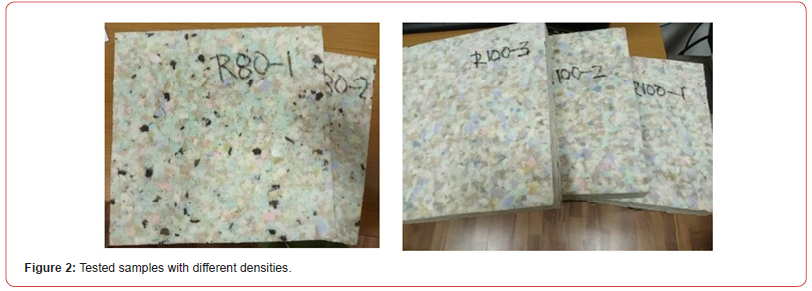
Table:1Measured masses, dimensions, volumes and densities of tested samples.

Table:2Comparison of density and mass of dry and wet samples.

Water absorption of polyurethanes
Polyurethanes typically come in many different forms, including solids and foams, which exhibit varying levels of water absorption. Rigid polyurethane foam typically exhibits low tendency to absorb water due to its closed cell structure and hydrophobic nature. Current research shows that water absorption performed in the laboratory is usually below 2%. For this reason, rigid polyurethane foam outperforms other insulation materials in terms of water resistance. Therefore, according to the new Spanish regulation, for example, rigid polyurethane foam is the only insulating material that can achieve the maximum level of water resistance on facades without additional requirements. The increased humidity of thermal insulation materials, in general, has an adverse effect on their insulation capacity, achieved with their porosity and air content. This means, that the water entering the pores of the material displaces the air, thereby directly increasing the thermal conductivity of the thermal insulation material. Such behavior is logical, because water has a thermal conductivity 25 times higher than air (λwater= 0.6 W/m·K). During their life cycle, recycled polyurethane foams can often be exposed to wet environments for extended periods of time. However, moisture generates heterogeneous fields of internal stresses in this type of material, which leads to changes in thermal and mechanical properties. Therefore, it is interesting to predict the water absorption for all formulations in order to assess their sustainability. In addition to the thermal characteristics of recycled re bonded polyurethane foam samples, they were also examined after water absorption. Six of the samples were exposed to water, placed in a container filled with water for 24 hours in the laboratory. Table 2 shows the values for the masses and densities of the dry and water-saturated samples. It can be noticed that the water-saturated samples have an almost three-fold increase in the measured mass and density compared to the dry samples. It is very logical that a change in the material properties would also be expected as a result of the water saturation of the samples (Table 2).
The absolute humidity of the material represents the amount of water, which is contained in the capillaries, pores and on the surface of the material in a unit of its mass:

where:
𝐻𝑎 is absolute humidity of the material,
𝑚𝑜𝑣 is mass of the wet material, [kg]
𝑚𝑜 is mass of the dry material, [kg]
𝑚𝑣 is mass of the absorbed water, [kg], 𝑚𝑣 = 𝑚𝑜𝑣 – 𝑚𝑜
Accordingly, the relative humidity is expressed by the equation:

Results and Discussion
Testing of dry samples
Samples with design density of 100 kg/m3: The three samples from the first series of recycled polyurethane foam samples are with design density of 100 kg/m3. The thickness of the samples is about 5 cm, while the real density of the material is different for all three samples: 97.10 kg/m3, 107.84 kg/m3 and 95.25 kg/m3, respectively for each of the samples, as shown in Table 1. The duration of the examination of each of the samples depends on the achievement of thermal equilibrium. Thermal conductivity for the first sample is λ1,100 = 0.039814 W/m·K. Thermal conductivities of the second and the third sample are λ2,100 = 0.039165 W/m·K and λ3,100 = 0.0399988 W/m·K, respectively. Presentation of the results in the software Qlab for the third sample is given in Figure 3 (Figure 3).
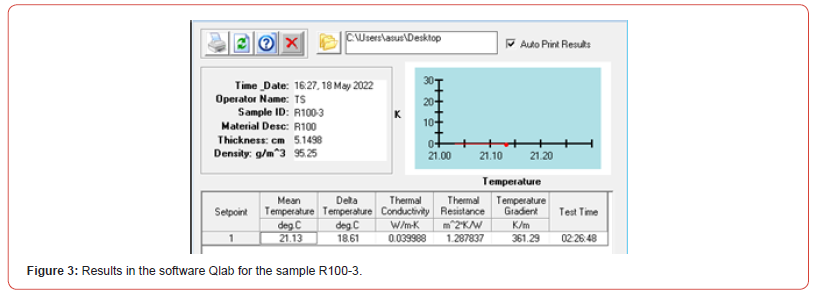

The mean test temperature for the three samples of the first group is about 20.78 °C, while the temperature difference between the hot and cold plate is about 18.1°. The mean value of the three samples of the recycled polyurethane foam R100, presented in Figure 4, shows that the thermal conductivity is λ100 = 0.039659 W/ mˑK ≈ 0.0397 W/mˑK (Figure 4).
Samples with design density of 80 kg/m3: The thickness of the samples from the second series of recycled polyurethane foam samples is about 5 cm, while the density of the material is different for all three samples, i.e., it is 79.27 kg/m3, 91.47 kg/m3 and 97.08 kg/m3 respectively for each of the samples. The second and especially the third sample are closer to the first design density of the material. The measured values for the thermal conductivity for all three samples of the recycled foam R80 are: 0.03896 W/mˑK, 0.03922 W/mˑK and 0.03844 W/mˑK, respectively, while the average value of the thermal conductivity for the second series of 80 kg/ m3 is λ100 = 0.03887 W/mˑK ≈ 0.039 W/mˑK, as presented in Figure 5 (Figure 5).
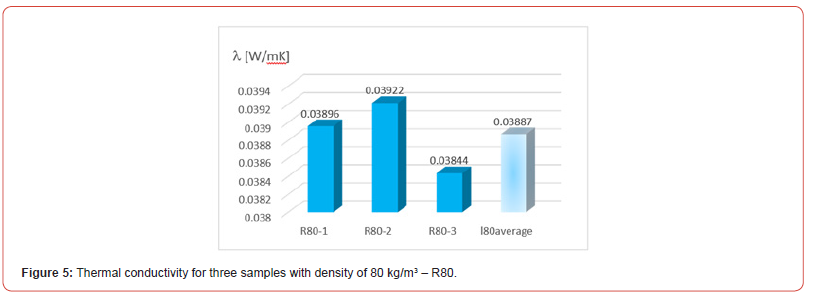
Samples with design density of 60 kg/m3: The calculated densities of the third series of samples R60, with design density of 60 kg/m3, are 57.71 kg/m3, 53.95 kg/m3 and 56.10 kg/m3, respectively for each of the samples. The second and especially the third sample are closer to the first design density of the material. Measured thermal conductivities of the samples are: λ160 = 038816 W/m·K, λ260 = 0.038807 W/m·K and λ360 = 039146 W/m·K. Average value for the third series R60 is l60 = 0.038923 ≈ 0.039 W/mˑK. They are presented in Figure 6 (Figure 6).
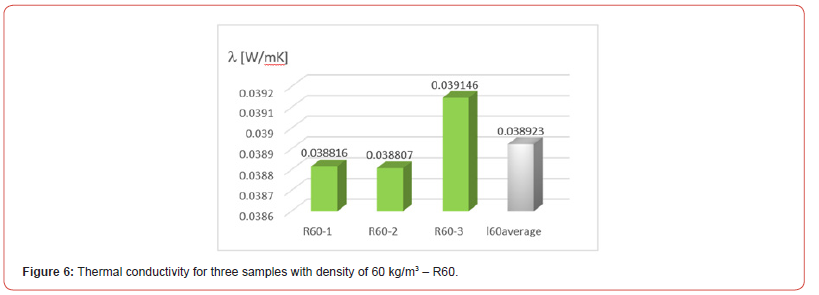
Comparison of all dry samples: The values for the thermal conductivity for all 9 dry tested samples, in terms of heat transfer, are summarized in Figure 7. From the tests carried out, it can be concluded that the thermal conductivity for all three different densities is within a narrow range, i.e., from 0.03844 W/m·K to 0.03981 W/m·K. The average value of all nine samples for the thermal conductivity is λaverage DRY = 0.03915 ≈ 0.039 W/mˑK, see Figure 7. This value is higher than the value of polyurethane foam panels obtained in a standard manner, but still competitive with other conventional materials commonly used for thermal insulation, such as mineral wool and polystyrene (Figure 7).

Typically, the density affects all properties in building materials, including thermal conductivity. A lower density always implies a higher porosity, and thus a lower heat conductivity. But in this case, due to the inhomogeneity of the material, which is visible in the photographs of the dry samples, Figure 2, it turned out that varying the density of 60, 80 and 100 kg/m3 has practically no noticeable effect, even with the accuracy of the conducted test of 0.1%. The difference between the highest and the lowest value of the obtained thermal conductivity is 0.137%, indicating that the density variation has no effect on the thermal conductivity of the recycled rebonded polyurethane foam.
Water absorption of samples
Using equations (4) and (5), the absolute and relative humidity for the treated samples were calculated and shown in Table 3. Table 3 presents that the rebonded recycled polyurethane foam has a pronounced water absorption, which is not a characteristic of ordinary (non-recycled) polyurethane foam. Namely, the average relative humidity of the six wet samples is 65.27%, while the average absolute humidity is as much as 188.43%. As a result of the open porosity of the newly obtained rebounded samples of recycled polyurethane, the filtration of water through the connected pores and voids of the material is enabled and their ability to absorb water increases significantly (Table 3).
Table:3Relative and absolute humidity of samples.

The effects of water penetration on thermal conductivity have been studied by many researchers, who have concluded that the thermal conductivity of composite materials increases with volumetric water content. The origin of this increase is due to water saturation, because water occupies the open pores of the materials. Water molecules change the structure and properties of the fibers, the matrix and the interface between them, which leads to the loss of compatibility between the fibers and the matrix and to the reorientation of the chain and shrinkage of the matrix, also leads to the degradation of the natural fibers by the mechanism of hydrolysis.
Thermal conductivity of wet samples
Table:4Densities and thermal conductivities of all wet samples.

After immersing the samples and determining their density, mass and humidity, their thermal conductivity was also measured in the Heat Flow Meter 436/3 instrument, in order to see the influence of humidity on the thermal conductivity of the material. Immersion in water of the samples of the recycled rebonded polyurethane foam showed that they have a high water absorption in contrast to the usual polyurethane foams obtained in a classical way. Namely, the average relative humidity of wet samples is 65.27%, while the average absolute humidity is 188.43%, as shown in Table 3 previously.
The thermal conductivity of wet samples for all three different densities is the range of 0.097 W/m·K tо 0.131 W/m·K, as shown in the above Table 4 and in the diagram in Figure 8. The average value of the thermal conductivity for all six tested wet samples is λaverage, wet = 0.1152 ≈ 0.115 W/m·K.
Comparison of dry and wet samples
Table:5Masses, densities and thermal conductivities of dry and wet samples.

Recycled rebonded polyurethane foam exhibits different properties than classic polyurethane foam. As a consequence of its inhomogeneous composition and the uneven distribution of macroparticles, larger pores and voids are formed in the pressed plates. Due to the greater open porosity of the material, the water absorption of the analyzed six samples is significant. The measured masses of the samples after wetting show an increase of 2.682 times up to 3.066 times more than the dry samples, or an average of 2.884 times the increase in mass compared to the mass of the dry samples. Accordingly, this high-water absorption of the rebonded recycled polyurethane foam affects the increase in the thermal conductivity. The thermal conductivity of the wet samples is increased by 2.5 to 3.34 times that of the dry samples, or on average the thermal conductivity is 2.96 times higher than the conductivity of the dry samples. Table 5 shows the masses, densities, and thermal conductivities of all tested samples in dry and wet conditions. Several conclusions can be drawn from the values shown in the table (Table 5).
Figure 9 shows the thermal conductivities of the dry and wet samples for the respective densities, as well as the average conductivities for both states of the examined samples. The values for the dry samples in the figure 9 are shown in solid color, and for the wet samples with a hatched fill on the bars (Figure 9).
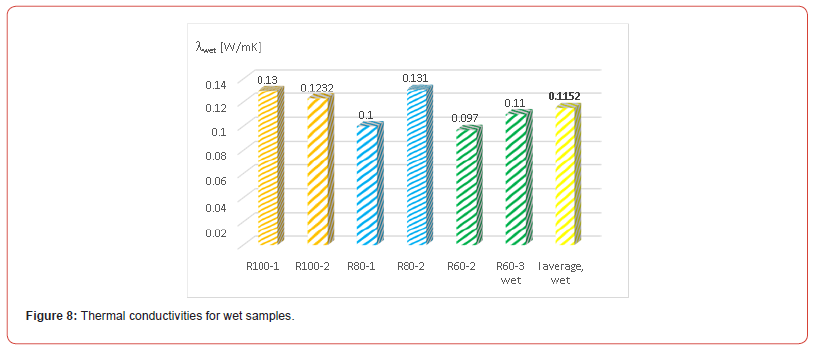
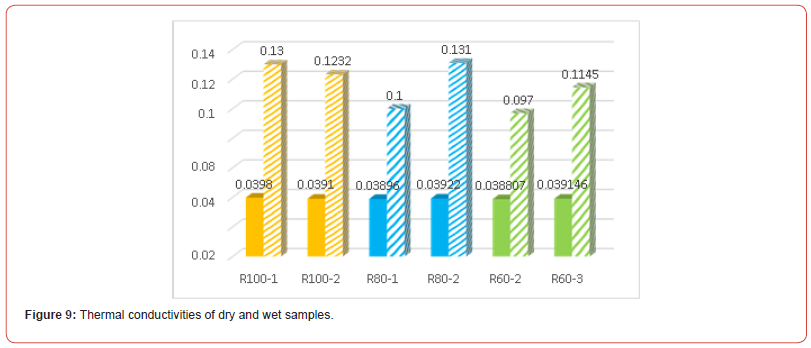
Figure 10 summarizes the average values of the thermal conductivities of the dry and wet samples. The values for the dry samples in the diagram in Figure 10 are presented in blue solid color, and the values for the examined wet samples are shown in red hatched pattern (Figure 10).
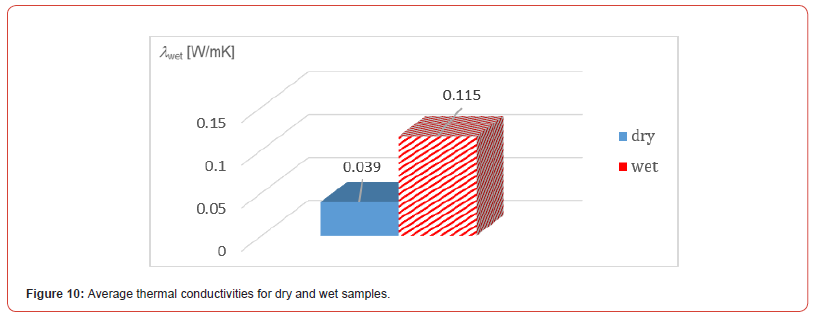
The greatest attention should be paid to the protection of recycled rebonded polyurethane from the influence of water and moisture. Protection with waterproof materials on both sides of the thermal insulation material is mandatory, due to the previously shown unfavorable influence of water on the thermotechnical characteristics of the material.
Conclusion
The range of thermal insulation materials is wide, but the choice of the most suitable material depends on many factors. In this paper, the recycled rebonded polyurethane foam is considered, as one of the many materials that offer acceptable physical-mechanical and thermal insulation characteristics. The main advantage of recycling and waste processing relates to economy and investment costs. The final destination for most of the waste will be the landfill, until adequate markets are created for polyurethane waste materials. It is possible to produce new materials by recycling and recovering polyols from waste polyurethanes, and this process can reduce environmental pollution. Testing thermal properties of recycled rebonded polyurethane foams, presented in this paper, showed their advantages and possible application. The type of hot and cold plate instrument testing technology is applicable to porous material such as recycled rebonded polyurethane foam. Tests have shown to what extent a change in material density or humidity can affect the thermal conductivity λ. In fact, varying the density from 60 to 100 kg/m3 has virtually no noticeable effect on thermal conductivity, even with a test accuracy of 0.1%. It is due to the inhomogeneous structure of the material. The average value of the thermal conductivity of the dry samples is 0.039 W/m·K. According to the conducted research, the recycled rebonded foam showed a pronounced water absorption in all tested water-saturated samples, in contrast to the behavior of the standard polyurethane foam. The mass of the water samples is almost three times greater than the mass of the dry samples, and consequently their density. And for the water-saturated samples, similarly as before, the difference between the highest and the lowest value of the thermal conductivities obtained is 3.4%, which shows that the density variation has no influence on the thermal conductivity of the wet recycled rebonded polyurethane foam. The average value of the thermal conductivity of the wet recycled foam is 0.115 W/m·K, which is 2.95 times higher than that of the dry samples.
Finally, it can be concluded that the recycled polyurethane foam has excellent thermal characteristics. The obtained value of the thermal conductivity of 0.039 W/m·K, showed that it can find its place of application and justification. It is comparable to other conventional materials for thermal insulation, i.e. it has a thermal conductivity within the limits of thermal conductivity characteristic for thermal insulation materials. Recycled polyurethane foam can compete with materials based on mineral wool or polystyrene, which are the most used and dominant in the thermal insulation market. For example, rock wool has a thermal conductivity from 0.033 to 0.041 W/m·K depending on the density and the method of pressing, while the expanded polystyrene has a value from 0.031 W/m·K to 0.04 W/m·K. In addition, this new material also solves the problem of waste and environmental pollution. The material obtained in this way offers an aesthetic experience in pastel colors, without being covered with additional finishing coatings. Architecturally, it has all the properties of a decorative material for interior decoration. With further proof of its sound-absorbing properties in future research, it would be an ideal material for interior wall and ceiling cladding, offering both beauty and thermos - acoustic comfort. The built-in thermal insulation from recycled polyurethane waste increases the value of the building, the quality of living, has a direct impact on energy savings, i.e. reducing heating costs, a parameter that is of particular importance, both from an economic and environmental conservation point of view. Polyurethane waste is repurposed for reuse, and it does not pose a potential threat to the environment.
The general conclusion of the analysis in this paper is that polyurethane waste is applicable in construction and similar industries as thermal insulation material, i.e. thermal insulation materials made from recycled rebonded polyurethane have an excellent future in the construction industry. Depending on its cost, the analyzed insulating material can be a good challenge for buildings’ thermal insulation and find its place in the market of thermal insulating building materials.
Acknowledgement
The research work has been carried out under the support of the Faculty of Civil Engineering, Ss. Cyril and Methodius University in Skopje. Testing materials were provided as a part of the project “Development and production of rubber-steel elements and products from recycled polyurethane foam for protection against noise and vibration”, financed by FITR—Fund for Innovation and Technology Development of R. Macedonia.
Conflict of Interest
No conflict of interest.
References
- Plastics Europe and EPRO (2016) Plastics – the Facts: An analysis of European plastics production, demand and waste data. Belgium.
- Gómez Rojo R, Alameda L, Rodríguez A, Calderón V, Gutiérrez González S (2019) Characterization of Polyurethane Foam Waste for Reuse in Eco-Efficient Building Materials. Polymers 11(2): 359.
- He P, Ruan H, Wang C, Luc H (2021) Mechanical Properties and Thermal Conductivity of Thermal Insulation Board Containing Recycled Thermosetting Polyurethane and Thermoplastic. Polymers 13(24): 4411.
- Simón D, Borreguero AM, de Lucas A, Rodríguez JF (2018) Recycling of polyurethanes from laboratory to industry, a journey towards the sustainability. Waste Manag 76: 147-171.
- Kiss G, Rusu G, Peter F, Tanase I, Bandur G (2020) Recovery of Flexible Polyurethane Foam Waste for Efficient Reuse in Industrial Formulations. Polymers 12(7): 1533.
- Guo L, Wang W, Guo X, Hao K, Liu H, et al. (2022) Recycling of Flexible Polyurethane Foams by Regrinding Scraps into Powder to Replace Polyol for Re-Foaming. Materials 15(17): 6047.
- Randall D, Lee S (2002) The Polyurethanes Book. Wiley, New York.
- Yang W, Dong Q, Liu S, Xie H, Liu L, et al. (2012) Recycling and Disposal Methods for Polyurethane Foam Wastes. Procedia Environmental Sciences 16: 167-175.
- Edurne E Aranberri I, Zhou X, Kastiukas G, Alduncin JA (2021) Sustainable insulating foams based on recycled polyurethanes from construction and demolition wastes. Open Research Europe 1: 37.
- Wang X, Pan Y, Shen C, Liu C, Liu X (2018) Facile Thermally Impacted Water-Induced Phase Separation Approach for the Fabrication of Skin-Free Thermoplastic Polyurethane Foam and Its Recyclable Counterpart for Oil–Water Separation. Macromol Rapid Commun 39(23): e1800635.
- Sonnenschein MF (2021) Polyurethanes: science, technology, markets, and trends. John Wiley & Sons, USA.
- Tantisattayakul T, Kanchanapiya P, Methacanon P (2018) Comparative waste management options for rigid polyurethane foam waste in Thailand. Journal of Cleaner Production 196(5): 1576-1586.
- Jovanoska Mitrevska M, Mickovski V, Samardzioska T, Iannace G (2022) Experimental and Numerical Investigation of Sound Absorption Characteristics of Rebonded Polyurethane Foam. Appl Sci 12(24): 12936.
- Manual for Heat Flow Meter – HFM 436 Lambda, Analyzing & Testing. NETZSCH-Gerätebau GmbH.
- MKS ISO 8301:2016 Thermal Insulation-Determination of steady-state thermal resistance and related properties-Heat flow meter apparatus.
-
Todorka Samardzioska* and Milica Jovanoska-Mitrevska. Recycled Rebonded Polyurethane Foam as Sustainable Thermal Insulation. Cur Trends Civil & Struct Eng. 9(4): 2023. CTCSE.MS.ID.000719.
-
Recycled rebounded polyurethane, Thermal conductivity, Energy, Buildings, Thermal insulation, Greenhouse
-

This work is licensed under a Creative Commons Attribution-NonCommercial 4.0 International License.
- Abstract
- Introduction
- Natural Geological Structure
- Evolution History of Landslide
- Development Characteristics of Jiangdingya Landslide
- Analysis of Catastrophe Mechanism of Landslides
- Stability Analysis of Landslide
- Safety Treatment of Landslide
- Conclusion
- Acknowledgement
- Conflicts of Interest
- References






